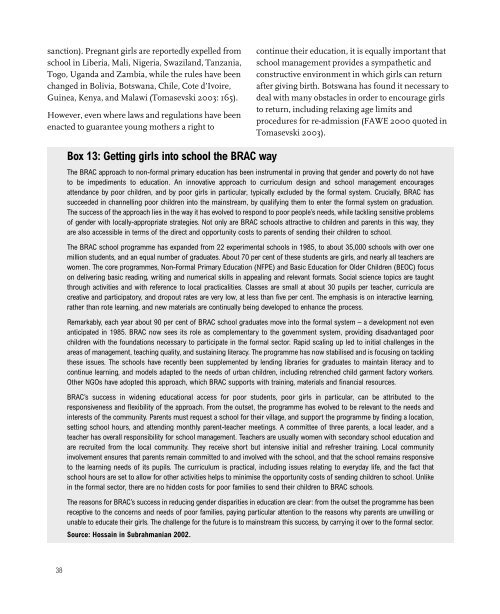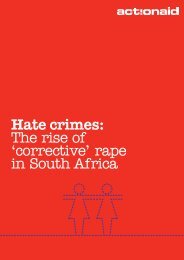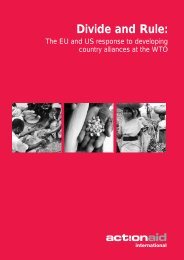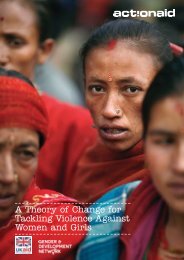A fair chance - United Nations Girls' Education Initiative
A fair chance - United Nations Girls' Education Initiative
A fair chance - United Nations Girls' Education Initiative
You also want an ePaper? Increase the reach of your titles
YUMPU automatically turns print PDFs into web optimized ePapers that Google loves.
sanction). Pregnant girls are reportedly expelled fromschool in Liberia, Mali, Nigeria, Swaziland, Tanzania,Togo, Uganda and Zambia, while the rules have beenchanged in Bolivia, Botswana, Chile, Cote d’Ivoire,Guinea, Kenya, and Malawi (Tomasevski 2003: 165).However, even where laws and regulations have beenenacted to guarantee young mothers a right tocontinue their education, it is equally important thatschool management provides a sympathetic andconstructive environment in which girls can returnafter giving birth. Botswana has found it necessary todeal with many obstacles in order to encourage girlsto return, including relaxing age limits andprocedures for re-admission (FAWE 2000 quoted inTomasevski 2003).Box 13: Getting girls into school the BRAC wayThe BRAC approach to non-formal primary education has been instrumental in proving that gender and poverty do not haveto be impediments to education. An innovative approach to curriculum design and school management encouragesattendance by poor children, and by poor girls in particular, typically excluded by the formal system. Crucially, BRAC hassucceeded in channelling poor children into the mainstream, by qualifying them to enter the formal system on graduation.The success of the approach lies in the way it has evolved to respond to poor people’s needs, while tackling sensitive problemsof gender with locally-appropriate strategies. Not only are BRAC schools attractive to children and parents in this way, theyare also accessible in terms of the direct and opportunity costs to parents of sending their children to school.The BRAC school programme has expanded from 22 experimental schools in 1985, to about 35,000 schools with over onemillion students, and an equal number of graduates. About 70 per cent of these students are girls, and nearly all teachers arewomen. The core programmes, Non-Formal Primary <strong>Education</strong> (NFPE) and Basic <strong>Education</strong> for Older Children (BEOC) focuson delivering basic reading, writing and numerical skills in appealing and relevant formats. Social science topics are taughtthrough activities and with reference to local practicalities. Classes are small at about 30 pupils per teacher, curricula arecreative and participatory, and dropout rates are very low, at less than five per cent. The emphasis is on interactive learning,rather than rote learning, and new materials are continually being developed to enhance the process.Remarkably, each year about 90 per cent of BRAC school graduates move into the formal system – a development not evenanticipated in 1985. BRAC now sees its role as complementary to the government system, providing disadvantaged poorchildren with the foundations necessary to participate in the formal sector. Rapid scaling up led to initial challenges in theareas of management, teaching quality, and sustaining literacy. The programme has now stabilised and is focusing on tacklingthese issues. The schools have recently been supplemented by lending libraries for graduates to maintain literacy and tocontinue learning, and models adapted to the needs of urban children, including retrenched child garment factory workers.Other NGOs have adopted this approach, which BRAC supports with training, materials and financial resources.BRAC’s success in widening educational access for poor students, poor girls in particular, can be attributed to theresponsiveness and flexibility of the approach. From the outset, the programme has evolved to be relevant to the needs andinterests of the community. Parents must request a school for their village, and support the programme by finding a location,setting school hours, and attending monthly parent-teacher meetings. A committee of three parents, a local leader, and ateacher has overall responsibility for school management. Teachers are usually women with secondary school education andare recruited from the local community. They receive short but intensive initial and refresher training. Local communityinvolvement ensures that parents remain committed to and involved with the school, and that the school remains responsiveto the learning needs of its pupils. The curriculum is practical, including issues relating to everyday life, and the fact thatschool hours are set to allow for other activities helps to minimise the opportunity costs of sending children to school. Unlikein the formal sector, there are no hidden costs for poor families to send their children to BRAC schools.The reasons for BRAC’s success in reducing gender disparities in education are clear: from the outset the programme has beenreceptive to the concerns and needs of poor families, paying particular attention to the reasons why parents are unwilling orunable to educate their girls. The challenge for the future is to mainstream this success, by carrying it over to the formal sector.Source: Hossain in Subrahmanian 2002.38
















